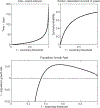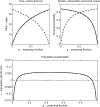Hierarchical demography: a general approach with an application to honey bees
- PMID: 19323239
- PMCID: PMC6761922
- DOI: 10.1890/08-0402.1
Hierarchical demography: a general approach with an application to honey bees
Abstract
Hierarchical population structure, where individuals are aggregated into colonies or similar groups that themselves grow, survive or perish, and potentially produce offspring groups, is an important feature of many biological systems, most notably eusocial organisms such as the honey bee, Apis mellifera. Despite this hierarchical structure, there is a paucity of analytical models and theory linking the dynamics of individuals within colonies to the dynamics of a population of colonies. We present an analytical framework that provides a simple, robust, and predictive theory for the population dynamics of hierarchical organisms. Our framework explicitly describes and links demographic dynamics for the different levels in the hierarchy (individuals, groups, population). We illustrate the application of the framework by developing a model for honey bees and analyzing the effects of life history traits such as worker life span and size at swarming on the growth rate of populations. We conclude by discussing possible extensions of the model that increase its realism and expand its usefulness beyond swarm-founding, monogynous, eusocial insects.
Figures





References
-
- Beggs KT, Hamilton IS, Kurshan PT, Mustard JA, and Mercer AR. 2005. Characterization of a D2-like dopamine receptor (AmDOP3) in honey bee, Apis mellifera. Insect Biochemistry and Molecular Biology 35:873–882. - PubMed
-
- Brian MV 1965, Social insect populations. New York, NY, Academic Press.
-
- Brian MV 1983, Social insects: ecology and behavioural biology. New York, NY, Chapman and Hall.
-
- Carey JR 1993, Applied demography for biologists with special emphasis on insects. New York, Oxford University Press.
Publication types
MeSH terms
Grants and funding
LinkOut - more resources
Full Text Sources
